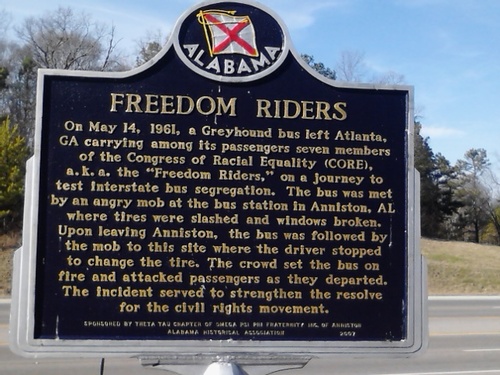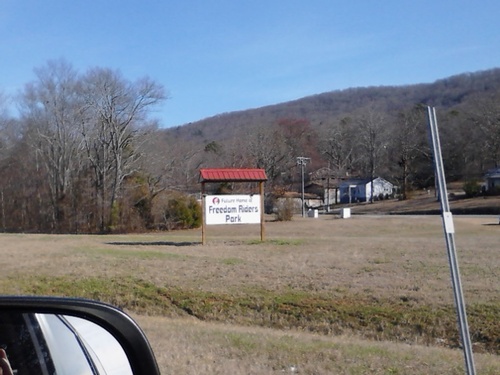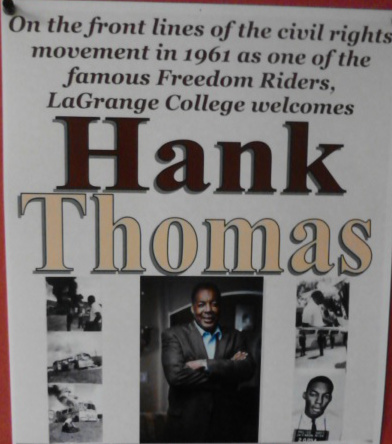Hank Thomas, one of three living Freedom Riders still alive from the May 14, 1961 bus firebomb attack in Anniston, Alabama, spoke before a mixed audience at a Georgia college recently. His message wasn't just one of racial reconciliation. It was about "allies."
For those who don't know, the Congress Of Racial Equality (CORE) sent out two integrated teams to see if bus terminals were desegregated or not. When they reached Anniston, Alabama, a mob attacked the bus. At the climax, the Greyhound bus was firebombed. Thomas and fellow bus passengers were then beaten as they escaped, and received little help from the local hospital.

Photo of the sign commemorating the firebombing of the Greyhound bus outside Anniston taken by the author.
"That was America," Thomas pointed out. "That wasn't Nazi Germany, the Soviet Union or the Ukraine."
One might expect Thomas to be pretty angry, condemning whites, but that wasn't his message. It was one of unity, between blacks and whites, as the key in the civil rights struggle.
"When we won World War II, the headlines said 'The Allies defeat the Nazis,'" he told the audience and those who had to watch the event in the overflow room. "They didn't say one country alone, but 'The Allies.'"
Thomas continued "And we had allies in the civil rights struggle. Whites stood and marched with us. The Jews were out there. There were even Holocaust survivors with us on the picket line. This grateful Gentile says thanks...Lest that I forget thee, O Jerusalem."
When a student asked him for advice about the difficulty of biracial conversations, Thomas had a surprise in store for us. "We've always heard that whites have to start the conversation. But blacks should go out of their way to talk with whites, and not just about sports."
Thomas also talked about how he, and some other members of the civil rights movement, served in the military. Thomas received several medals, including the Purple Heart, fighting for America in the Vietnam War.
"What will your legacy be?" he challenged the students, staff, faculty, administrators, and members of the community.
Afterwards, when we got a chance to chat at the college dining hall, I asked "what should the media do?" After all, he had been critical of some media coverage of racial relations.
"The media has a social responsibility to report the positive, not just the negative," Thomas told me. He then brought up a story about how he tried to call the press about a low income school he was helping, which had a record number of ROTC members get into service academies. "They weren't interested in covering the story. But when someone called them about a rumor of a gang fight, they showed up in 15 minutes. Good news about racial relations is all over the place. You just have to cover it."
Surveying the LaGrange College campus cafeteria, Thomas added "Here's a good example. This is one of the most integrated groups of students I've ever seen. The only place I've seen this much integration is at Ole Miss, where they are making a conscious effort to promote blacks and whites sitting together."

Site of the future Freedom Rider Park to commemorate the events of May 14, 1961. Photo by the author.
John A. Tures is a professor of political science at LaGrange College in LaGrange, Ga. He can be reached at jtures@lagrange.edu.

